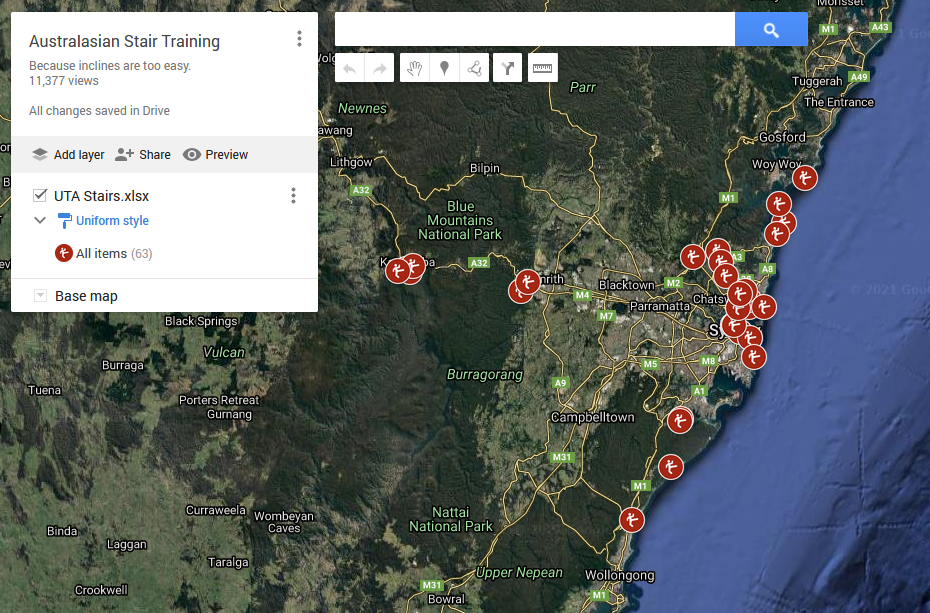Whatever your race distance, Ultra-trail Australia is one of the most challenging Ultra’s on the continent and proper preparation can be the difference between masterful execution and a difficult day in the Blue Mountains.
When training for an ultra it is important to recognise what training interventions should be considered when in order to make best use of your time. Early in training the focus should be on developing cardiovascular fitness with a transition to improving economy and speed though February, March and April. So too is it useful to prepare the body for the specific demands of elevation and terrain.
A good program to Ultra-trail Australia is one that increase specificity over time. Initially with easy running on any surface while the athlete develops base fitness, gradually introducing strength and speed work over time, until ‘race-like’ terrain becomes common place in an ordinary training week.

The Training Specificity Pyramid
Think of it as a pyramid in three parts. The biggest and widest base block being core fitness established through the accumulation of easy jogging. The middle piece of the pyramid being integrated strength work, stairs, and hill running and training on terrain that resembles in some part the demands of the Blue Mountains, Megalong, Kedumba etc. The very top of the pyramid being the thin slice of genuinely hard fast running and explosive strength work that builds muscle and resilience (and at greatest risk of injury). All the while the pyramid is built with interventions from least specific at the bottom to mot specific at the top.
Stairs – there’s plenty. They have a place throughout the pyramid but more-so at the top and while your mind may be on them in the early training it’s more essential that they are a pressing consideration from February onwards.
For those that don’t have access to trails with stairs, consider stairwells, StairMaster machines or any obvious best-fit substitute. In a complete absence prioritise your strength work.

Our Australasian guide on the best stairs near you
A consideration for Eccentric Strength (downhill running)
3 out of 4 Ultra-trail Australia races have the pleasure of an extensive downhill section into the Kedumba Valley. Athletes consider these kms an excellent opportunity to open up and run freely only realising afterwards the impact hard downhill running has had on their muscles as they attempt to climb out of the Leura Forest. With almost 3000m of elevation across the 100km course and ample in the 11, 22, and 50km distances, Ultra-trail Australia is a course with just as many DOWNS as there are UPS. All too often athletes (and coaches) focus on developing uphill strength without consideration for the impact that all those ‘downs’ will have on race day. Lack of eccentric strength can be show-stopper however some simple interventions may greatly reduce the impact of those downhill kms.
- Eccentric downhill running such should be introduced as little as fortnightly and as much as weekly in the top two pieces of the strength and specificity pyramid. Try running faster on downhill sections of undulating training runs or committing to a specific prolonged downhill at a higher tempo or RPE (Rate of Perceived Effort). Reduce the risk of impact injuries by gradually integrating these sessions into your training and ensuring your cadence (stride rate) remains high to avoid overstriding. Ideally your leg turn over is as fast downhill as it is elsewhere (flat etc).
- Eccentric unloading strength exercises such as depth jumps where you drop off step or box into a squat to arrest your fall with the unloading power of your quads. *This is something to work with a good PT on, as it comes with a risk of injury if planned poorly.
- Weighted downhill hiking with a pack on steep terrain can also induce overload stress in the quads however care is need to ensure the knees are protected. Patella Femoral pain below the knee is an early indication that you need to temper the application of this intervention.
Ensure your coach has made an allowance for your strength and specificity training in your program and consider engaging a specialist Sports Physiotherapist or qualified Personal Trainer to help develop an in-house, at-home to gym program.
